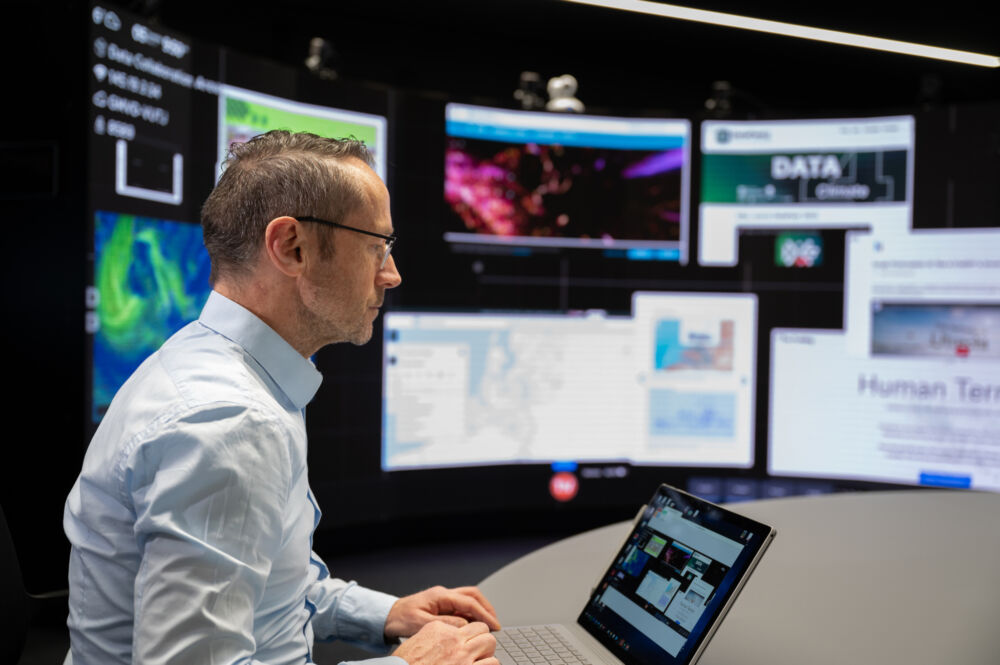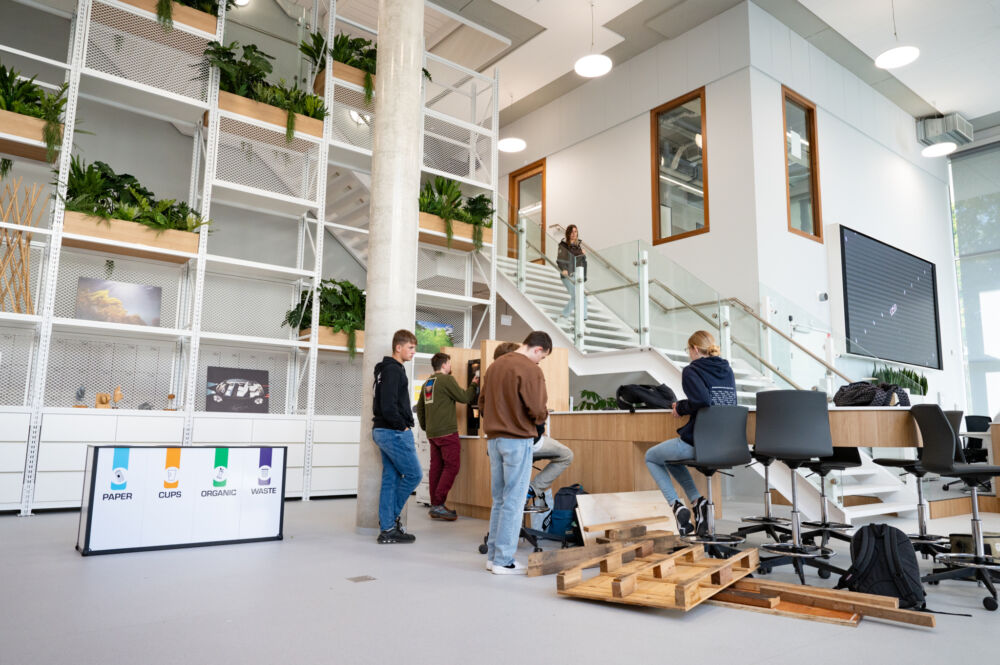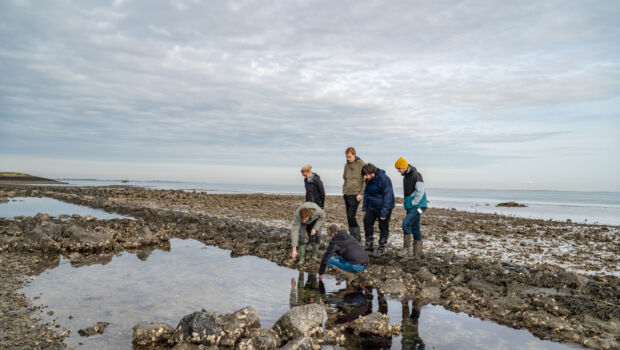The white building at Het Groene Woud in Middelburg immediately catches the eye: the Joint Research Center Zeeland (JRCZ). A unique research institute where students, researchers, companies and government institutions work together on solutions for urgent social issues in the Southwestern Delta.
Manager Leo Blok and Mischa Beckers, lecturer Data Science, explain how the JRCZ works in practice as a collaboration partner in and for the region.
Let's start at the beginning: how did it all start? What was the vision for the JRCZ?
Leo: “It all started in 2016. At that time, a committee led by former Prime Minister Jan Peter Balkenende concluded that Zeeland lacked high-quality research facilities. The report ‘Zeeland in stroomversnelling’ showed that Zeeland could structurally strengthen its economy by investing in technical education. The JRCZ is a result of this advice.
The JRCZ aims to strengthen Zeeland's knowledge infrastructure by bringing together education and the business community. The collaboration between three Zeeland educational institutions is crucial here: Scalda (mbo), HZ University of Applied Sciences (hbo) and University College Roosevelt (wo). From the start, we have been inspired by other educational institutions.
We visited the technical universities in Delft and Eindhoven to see how our vision could work in reality. The makerspaces, for example, that we have on every floor in the JRCZ. At the technical universities, we saw how a central space can be used for collaboration between students and researchers.”
Mischa, when did you join in this process?
Mischa: “At a certain point, the request came to think about the spaces in the JRCZ. If a Data Science Lab is being built, it makes sense for a Data Science lecturer to think about it. I was given a drawing with a number of spaces and the number of square meters and a free hand to furnish it. That was quite difficult, because you have to look at a drawing and then imagine the space and the needs.”
We have set up the Data Science Lab in the JRCZ based on the work process as a data scientist. Each phase in the process has been given its own space.
How did you approach it then?
Mischa: "Initially, I started sparring with colleagues Manuel Magallon and Jorick Vos about the space. We mainly looked at the work process a data scientist performs and from that process we started to design the spaces. The first phase in this process is business understanding and that is a very crucial one. If you get that step wrong, you start the process all wrong. So it is essential to get round the table with stakeholders. You can't do that remotely or on paper. You have to sit together and be able to look each other in the eye to ask the question: ‘What exactly is the problem?’"
What space was then devised for this phase?
Mischa: "The data theatre. There doesn't have to be a supercomputer there, but you have to be able to understand each other. So through visual aids you start talking to each other about the project and see if we can do things."
How does the process continue?
Mischa: “The further you get in the process, the more you can show of the data and the deeper you can go. The stakeholder is also important here, because if we encounter any remarkable things in the data, we have to ask the stakeholder again what could be going on. We do this in the collaboration area, where our large screen is located. This is a touch screen, but it also has a 3D option. The screen is equipped with special software, which allows us to overlay images and models, make notes and see things next to each other, group visualizations and applications and much more. Then we start solving the data problem. A data scientist must now be able to really go into depth, so we have set up the interaction lab for that. Here we have all the facilities we need: a mini supercomputer with enough processing power, 4K screens, you name it.”

How did you translate this vision into the final spaces in the JRCZ?
Mischa: “Together with Manuel and Jorick, I went on a study trip to explore all the possibilities. What is available in the Netherlands? What are best practices? For example, we visited Fontys and the University of Groningen to gain inspiration and listen to their experiences. Based on our wishes, our findings from the study trip and of course the budget, we started drawing the spaces piece by piece. During this process, we negotiated a lot and adjusted things where necessary, but we were always flexible and ultimately we are very satisfied with the end result. The Data Science Lab even won the award for the Best Overall AV-enabled Education Space at the international EUNIS conference. We are incredibly proud of that.”
When you both think back to the visions you started with and where we are now, where do we stand?
Leo: “The JRCZ has now been open for 1.5 years and I can really see that we have made great strides. The labs are now widely used by students and researchers.
In the makerspaces I see students and research groups coming together to make group work more effective. Presentations and meetings are organised there. I do think there is still room for improvement. For example, I would like to collaborate even more with the other domains of the HZ, even more intensively with UCR and Scalda, but certainly also more with external parties.”
What do you think, Mischa?
Mischa: “The Data Science Lab was up and running quickly. We were also able to experiment with the space and all the facilities for a while before large groups of students or other visitors started using the lab. How is it running now? My lectorate is located in the Data Science Lab and my colleagues are enthusiastic about using the spaces and the possibilities they offer. We also have a number of educational and research activities that take place in the Data Science Lab. The minor Applied Data Science, for example. Then you make optimum use of the facilities that are there.”
How far do you dare to think outside the box? If you can get creative with teaching and research, the JRCZ is one big playground full of possibilities.
Is there still room for improvement?
Mischa: “Certainly! The interaction lab and the collaboration area are used both internally by students and researchers and externally by local organizations. Here I often see that the full scope of the facilities is not used. Then external parties bring their own flipchart, so to speak, while we have a state-of-the-art screen! That is a shame, because there are enough people present in the JRCZ to show the possibilities of the facilities. In the Data Science Lab we have Loek van der Linde as lab manager, there are student assistants who can help and of course Leo and project employee Karen Vrolijk are always available. I really see room for growth there.”
Leo: “We do indeed have state-of-the-art facilities and spaces in the JRCZ, but people often experience a threshold to use them. You really have to be creative yourself.
There is so much possible in the JRCZ, but you have to figure out for yourself what you need and how the JRCZ can help you with that. How far do you dare to think outside the box? If you can be creative with your education and research, then the JRCZ is one big playground full of possibilities.” Mischa: “There are many students from Scalda who do internships in the JRCZ and they don’t see that threshold at all. They enter the JRCZ and just get started with that new equipment. They approach all that new equipment in a very creative way and, if necessary, figure out for themselves how it works. This is how a lot of content has already been created. That is really inspiring for students, researchers and visitors. That will pay off. There are now projects running such as Cool Neighbourhoods and FlexIntensity with other lectorates including Resilient Deltas and Delta Power respectively, where the facilities of the Data Science Lab will demonstrate their added value.”

We have now discussed internal user experiences. Do external organisations or institutions also use the JRCZ?
Mischa: “With teacher Jolene Cijsouw I gave a masterclass on Data Science to 12 municipalities in Zeeland. That was 3 days of intensive use of the possibilities we have in the JRCZ. That is a good example from the lectorate that will be continued for other organisations. In addition, lab manager Loek is a real ambassador of the Data Science Lab and tries to get as many people as possible into the lab to inspire them with the possibilities. For example, he sets up collaborations with the GGD and the ADRZ. But he also finds collaboration partners outside Zeeland. He is now working with students and the Nursing programme with an expert from a hospital in Amersfoort on an anatomical 3D model. The model itself is already very impressive on the big screen in the collaboration area, but with the application that the students have made you can also develop educational material and even tests. That is great!”
Leo: “The collaboration with the Zeeland business community is a two-way street. They have an issue for which they need our knowledge and facilities, but at the same time they also have unique knowledge and experiences with which they can enrich the JRCZ. It is often a snowball effect. For example, a business club comes to the JRCZ for a presentation on AI and then there is a representative of a company who still has an issue regarding engineering. We then help them further in that area within the JRCZ.”
Do you recognize this snowball effect, Mischa?
Mischa: “Yes, certainly! For example, Food Delta Zeeland is a consortium with which we have had a long-term collaboration and which has also visited the JRCZ several times. Then they have seen all the facilities and possibilities and then there is always someone who comes up with a new problem or issue. René Slabbekoorn from Artificial Intelligence Zeeland, for example, who is looking for AI solutions to make fruit growing machines more efficient. He is currently working on an assignment within the ICT programme. Students are now working on this issue in our lab."
Visitors and partners are proud of the JRCZ and all the facilities we offer. That we have such state-of-the-art labs here in Middelburg and thus strengthen the province.
Leo: “I also really notice that visitors and partners are proud of the JRCZ and all the facilities we offer. That we have such state-of-the-art labs right here in Middelburg and that we help and strengthen the province.”
Mischa: “I also have that experience with the DataFest, which we have now organized for the second time in the Data Science Lab. The province of Zeeland is one of the main sponsors and they have already said that they want to organize the DataFest specifically in the Data Science Lab again next year. In this way, the JRCZ is once again the link between a government institution and education, because students from Scalda, HZ and UCR participate in the DataFest. These are very nice connections.”
What future plans do you have for the JRCZ?
Leo: “I think that the makerspaces can be used even better. Different departments can seek each other out there and help each other. In addition, I think that education in the JRCZ can be viewed in a creative and innovative way. How can we challenge students? How can we best facilitate teachers?"
Mischa: “With the opening of the Delta Climate Center (DCC), I also see many opportunities for collaboration with the JRCZ. Within this center, we are working on major multidisciplinary problems, which we can carry out excellently in the JRCZ labs. Issues concerning water management and safety are what the Scalda Water professorship and several HZ professorships are working on. We can visualize and present the solutions that are developed there beautifully on our screens within the Data Science Lab. That makes the experience so different.”
Leo: “I would also like to challenge visitors and users of the JRCZ to think along about improvements. What equipment is still missing? What could be arranged differently? What possibilities do they see? We want to relieve and facilitate users and visitors, so if you are missing something or have ideas, please contact us.”

Data Science
The Data Science research group carries out applied research into the creation of data products. It focuses particularly on products that are important in a delta area such as Zeeland, for example for coastal protection, safety, tourism, food, industry, energy and logistics. The lectorate works together with entrepreneurs, governments and other research groups so that data products can be combined with knowledge from these domains.
Read more about the lectorate Data Science

